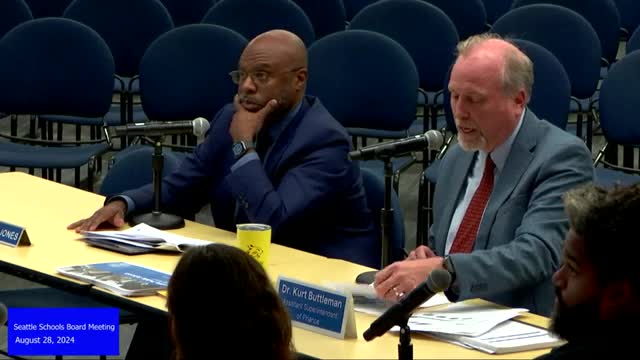Seattle Schools Face $94 Million Deficit Without Action
August 28, 2024 | Seattle School District No. 1, School Districts, Washington
This article was created by AI summarizing key points discussed. AI makes mistakes, so for full details and context, please refer to the video of the full meeting. Please report any errors so we can fix them. Report an error »

Seattle Public Schools is facing a projected $94 million deficit for the 2025 fiscal year if no changes are made to its financial strategies. This alarming figure highlights the urgent need for action as the district grapples with chronic underfunding and rising operational costs.
During a recent government meeting, officials discussed the average annual underspend, which has ranged between $10 million and $30 million over the past five years, influenced by factors such as salary lapses and unspent supply budgets. While this underspend may provide temporary relief, it is not a sustainable solution to the looming deficit.
The district has also decided to deplete its rainy day fund to balance the upcoming budget, a move that reflects the dire financial situation. Officials emphasized that even with full implementation of recommended budgetary changes, the district would still face deficits due to inadequate funding from the state legislature, which has not adjusted its funding model since 2009.
Per-student funding in Washington has decreased from $12,525 in the 2018-2019 school year to $11,588, adjusted for inflation, further exacerbating the financial strain on schools. The upcoming legislative session, set to begin on January 13, 2024, will be critical as the district must make staffing decisions before the session concludes on April 27.
Key areas of concern for the district include special education, material supplies, and transportation, with requests for funding in these areas totaling around $1 billion. However, officials warned that without addressing the underlying issues of the funding model and the state's regressive tax structure, these measures would only serve as temporary fixes.
The meeting underscored the need for a comprehensive approach to education funding in Washington, as multiple districts face similar financial challenges. The situation calls for urgent legislative action to ensure that schools can adequately meet the needs of their students in the long term.
During a recent government meeting, officials discussed the average annual underspend, which has ranged between $10 million and $30 million over the past five years, influenced by factors such as salary lapses and unspent supply budgets. While this underspend may provide temporary relief, it is not a sustainable solution to the looming deficit.
The district has also decided to deplete its rainy day fund to balance the upcoming budget, a move that reflects the dire financial situation. Officials emphasized that even with full implementation of recommended budgetary changes, the district would still face deficits due to inadequate funding from the state legislature, which has not adjusted its funding model since 2009.
Per-student funding in Washington has decreased from $12,525 in the 2018-2019 school year to $11,588, adjusted for inflation, further exacerbating the financial strain on schools. The upcoming legislative session, set to begin on January 13, 2024, will be critical as the district must make staffing decisions before the session concludes on April 27.
Key areas of concern for the district include special education, material supplies, and transportation, with requests for funding in these areas totaling around $1 billion. However, officials warned that without addressing the underlying issues of the funding model and the state's regressive tax structure, these measures would only serve as temporary fixes.
The meeting underscored the need for a comprehensive approach to education funding in Washington, as multiple districts face similar financial challenges. The situation calls for urgent legislative action to ensure that schools can adequately meet the needs of their students in the long term.
View full meeting
This article is based on a recent meeting—watch the full video and explore the complete transcript for deeper insights into the discussion.
View full meeting
